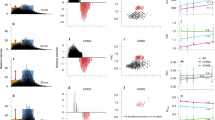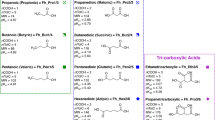Abstract
Fulvic acids are those components of soil organic matter that remain soluble after a dilute alkaline extract of the soil is acidified to pH 2 (refs 1, 2). This extraction procedure has been applied to marine sediments, and the organic compounds so recovered have been called marine sedimentary fulvic acids. These fulvic acids are thought to form more complex humic substances in marine sediments by condensation reactions3. However, the chemical structural compositions of marine fulvic acids have not been defined sufficiently to allow this precursor relationship to be made. Here NMR spectroscopy is used to identify more clearly the chemical structural components of some marine sedimentary fulvic acids, thus enabling a more useful examination of their relationship to more complex humic substances.
This is a preview of subscription content, access via your institution
Access options
Subscribe to this journal
Receive 51 print issues and online access
$199.00 per year
only $3.90 per issue
Buy this article
- Purchase on Springer Link
- Instant access to full article PDF
Prices may be subject to local taxes which are calculated during checkout
Similar content being viewed by others
References
Oden, S. Kolloidechem. Beihefte 11, 75 (1919).
Schnitzer, M. & Khan, S. U. Humic Substances in ihe Environment (Marcel-Dekker, New York, 1972).
Welte, D. in Advances in Organic Geochemistry (eds Tissot, B. & Bienner, F.) (Editions Technip, Paris, 1973).
Ogner, G. & Schnitzer, M. Can. J. Chem. 49, 1053–1063 (1971).
Neyroud, J. A. & Schnitzer, M. Can. J. Chem. 52, 4123–4132 (1974).
Swincer, G. D., Oades, J. M. & Greenland, D. J. Aust. J. Soil Res. 6, 225–235 (1968).
Martin, J. P. Soil Biol. Biochem. 3, 33–41 (1971).
Sequi, P., Guidi, G. & Petruzzelli, G. Can. J. Soil Sci. 55, 439–445 (1975).
Swincer, G. D., Oades, J. M. & Greenland, D. J. Aust. J. Soil Sci. 6, 211–224 (1968).
Rashid, M. A. & King, L. H. Geochim. cosmochim Acta 34, 193–201 (1970).
Whitby, L. M. & Schnitzer, M. Can. J. Soil Sci. 58, 167–178 (1978).
Stuermer, D. H. & Payne, J. R. Geochim. cosmochim. Acta 40, 1109–1114 (1976).
Ishiwatari, R. in Proc. int. Meet. Humic Substances, Nienrsluis (1972).
Schnitzer, M. Can. Spectrosc. 10, 121–127 (1965).
Stevenson, F. J. & Goh, K. M. Geochim. cosmochim. Acta 35, 471–483 (1971).
Vila, F. J. G., Lentz, H. & Ludemann, H. D. Biochem. biophys. Res. Commun. 72, 1063–1069 (1976).
Lentz, H., Ludemann, H. D. & Zeichmann, W. Geoderma 18, 325–328 (1977).
Sposito, G., Schaumberg, G. D., Perkins, T. G. & Holtzclaw, K. M. Encir. Sci. Technol. 12, 931–934 (1978).
Wilson, M. A., Jones, A. J. & Williamson, B. Nature 276, 487–489 (1978).
Hatcher, P. G., Rowan, R. & Mattingly, M. A. Org. Geochem. 2, 77–85 (1980).
VanderHart, D. L. & Retcofsky, H. L. Proc. Coal Chem. Symp. (Stanford Research Institute, 1976).
Gerchakov, S. M. & Hatcher, P. G. Limnol. Occanogr. 17, 938–943 (1972).
Stark, S. M. Jr. Analyt. Chem. 22, 1158–1160 (1950).
Sweeley, C. C., Bentley, R., Makita, M. & Wells, W. W. J. Am. chem. Soc. 85, 2497–2507 (1963).
Voelter, W. & Breitmaier, E. Org. Magn. Reson. 5, 311–319 (1973).
Schnitzer, M. & Kodama, H. Proc. Soil Sci. Soc. Am. 31, 632–636 (1967).
Vallentyne, J. R. in Organic Geochemistry (ed. Bregcr, T. A.) (Pergamon, London, 1963).
Prashnowsky, A., Degens, E. T., Emery, K. O. & Pimenta, J. N. Jb. Geol. paläont. Mh. 8, 400–413 (1961).
Steelink, C. J. chem. Educ. 40, 379–384 (1963).
Ernst, W. Veröff. Inst. Meeresforsch., Bremerh. 10, 81–92 (1966).
Wise, L. E. & Jahn, E. C. Wood Chemistry (Reinhold, New York. 1952).
Huc, A. Y. & Durand, B. in Advances in Organic Geochemistry (eds Tissot, B. & Bienner, F.) (Editions Technip, Paris, 1973).
Nissenbaum, A., Baedecker, M. J. & Kaplan, I. R. in Advances in Organic Geochemistry (eds V. Gaerther, H. R. & Wehner, H.) (Pergamon. Oxford, 1972).
Author information
Authors and Affiliations
Rights and permissions
About this article
Cite this article
Hatcher, P., Breger, I. & Mattingly, M. Structural characteristics of fulvic acids from Continental Shelf sediments. Nature 285, 560–562 (1980). https://doi.org/10.1038/285560a0
Received:
Accepted:
Issue Date:
DOI: https://doi.org/10.1038/285560a0
This article is cited by
-
Comparison study of sedimentary humic substances isolated from contrasting coastal marine environments by chemical and spectroscopic analysis
Environmental Earth Sciences (2016)
-
Chemical and spectroscopic characterization of dissolved humic substances in a mangrove-fringed estuary in the eastern coast of Hainan Island, China
Chinese Journal of Oceanology and Limnology (2013)
-
Indigenous 13C-NMR structural features of soil humic substances
Nature (1981)
Comments
By submitting a comment you agree to abide by our Terms and Community Guidelines. If you find something abusive or that does not comply with our terms or guidelines please flag it as inappropriate.



